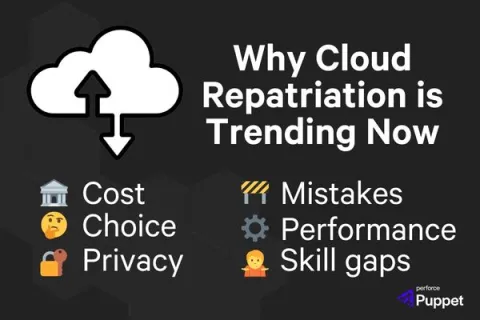Blog
January 9, 2025
Cloud Repatriation: Examples, 2025 Trends & Tips for Reverse Migration
Cloud,
Infrastructure Automation
If you moved to the cloud hoping for cost savings and scalability only to find that your cloud costs are ballooning, your cloud performance isn’t up to snuff, or you’re always struggling to align compliance regulations with your cloud deployment, it might be time to look into cloud repatriation as an alternative to public cloud infrastructure.
Moving anything from public cloud to private cloud or on-prem infrastructure this year? If so, you’ll need to know a bit about the phenomenon of cloud repatriation. Here’s an overview of what cloud repatriation is, what it looks like, why and how organizations are doing it, and how to cover your bases before doing it with your cloud infrastructure.
Table of Contents
- What is Cloud Repatriation?
- Cloud Repatriation in 2025: Are People Still Moving Workloads Off the Cloud?
- Reasons Cloud Repatriation is Trending Now & Drivers of Reverse Migration
- Cloud Repatriation Examples: What Cloud Repatriation Really Looks Like
- Pros & Cons of Cloud Repatriation
- 9 Considerations for Cloud Repatriation
- Using Automation & Configuration Management to Conduct a Smooth Cloud Repatriation
What is Cloud Repatriation?
Back to topCloud repatriation is the process of moving apps, services, and data off of public clouds (like AWS, Azure, or GCP) and back to data centers, on-premises, private cloud, or a hybrid setup. Companies choose cloud repatriation to reduce cost, improve privacy, and meet changing business needs.
Cloud Repatriation in 2025: Are People Still Moving Workloads Off the Cloud?
The short answer is yes, cloud repatriation is still very much a trend in 2025. Q4 2024 data showed that most repatriating organizations move select parts of their workloads back to on-prem or hybrid setups, rather than wholesale repatriation.
A few key findings from the end of 2024 can give us an indication of how the cloud repatriation trend will evolve in 2025:
- In 2025, repatriation is still generally an upward trend. Data from the end of 2024 showed that 86% of CIOs planned to move some public cloud workloads back to private cloud or on-premises — the highest on record for the Barclays CIO Survey.
- Very few organizations are moving everything off the cloud. In October 2024, an IDC survey found that only about eight percent of organizations are moving their entire workloads off the cloud. The majority of organizations doing cloud repatriation are only moving certain elements, like production data, backups, and compute resources.
- Public cloud spend is expected to increase in 2025. That means drastic repatriation probably won't be a trend. In November 2024, Gartner forecast $723.4 billion in worldwide public cloud spend for 2025, up 21% from $595.7 in 2024.
Overall, organizations with public cloud infrastructure are likely to keep at least some of it there in 2025. The rise of high-performance computing (HPC) for AI workloads is leading them to find ways to improve performance and reduce spend, like better tools for HPC configuration, as well as splitting workloads between cloud deployment and data centers.
Back to topReasons Cloud Repatriation is Trending Now & Drivers of Reverse Migration
Common reasons for cloud repatriation include cost, data privacy, security, compliance, performance, and avoiding vendor lock-in. Cloud repatriation usually follows a change in business strategy, when an organization reconsiders its cloud deployment model.
Cloud repatriation is trending in the 2020s because many organizations feel they moved to the cloud too much, too quickly during the COVID-19 pandemic.

With a growing need for cloud services that could be accessed by a remote workforce, organizations invested in public clouds for their apps, workflows, and data. Those companies adopted public cloud providers like AWS, Azure, and GCP at an astonishing rate, sold on its availability, cost savings, and ease of adoption.
But more recently, as business strategies and needs have changed, some companies are finding that their public cloud deployments might not be aligned with their goals for a number of reasons.
Common Reasons for Cloud Repatriation
When companies decide to move off their public cloud environment, it’s often due to one of these reasons:
- Cost: Costs of computing, storage, ingress/egress (data transfer), networking, licensing, management, and more are determined by the cloud provider, and are subject to inflation and fluctuating costs. A strategic cloud repatriation can help keep costs down.
The U.S. Bureau of Labor & Statistics's Producer Price Index (PPI) for Data Processing, Hosting and Related Services, which includes cloud computing, rose 6.4 percent between September 2023 and May 2024.
- Privacy and compliance: Using a public cloud to host sensitive data raises a lot of compliance questions. Where in the physical world is the data stored? Who has access to it? What happens in the event the cloud provider experiences disruptions or goes out of business? Ensuring compliance with relevant regulations is also a concern for public cloud users. They have to be sure that the public cloud they’re using can be configured to meet compliance standards like GDPR, HIPAA, and PCI DSS.
- Cloud security: In security, consistency is key — and, as some organizations are finding lately, difficult to ensure in public and hybrid cloud setups. A 2022 survey found that having to use multiple proprietary tools for cloud security created problems with visibility, policy enforcement, and centralized management across multiple clouds. In a world where downtime is becoming more frequent, more impactful, and more expensive, public cloud security is one area organizations aren't willing to risk consistency for cost savings.
Image

| Need to Scale Faster & Safer When Moving Cloud Workloads?Get our free guide for tips to ensure a more secure, more scalable cloud move. |
- Misconfiguration: When moving on and off the cloud, oversights and missteps that would otherwise have limited effect are suddenly much more impactful. In 2022, one misconfigured AWS S3 bucket exposed 3.2 million files of sensitive data at a Turkish airline, including flight data, source code, and personal info on airline crew.
- Performance: Public cloud can be less than ideal for workloads that need high-performance computing with low latency. Cloud repatriation can help boost performance by letting organizations pick a different cloud hosting option or moving affected resources off the cloud.
- Vendor lock-in: When you choose a public cloud provider for SaaS, PaaS, or IaaS, you’re dependent on that provider for it. Essentially, that means you need to keep paying them for access to the software, platform, or infrastructure you use up there.
- Skill gaps: A lack of deep technical know-how in the cloud tools you're using can put a huge bottleneck on your IT ops. If your team or SME is well-versed in just one vendor’s tech — say, they’re an expert in GCP but slower with AWS — that could also make your vendor lock-in problems worse.
Multi-cloud deployment is a great way to avoid being locked in to one vendor’s terms >>
Back to topCloud Repatriation Examples: What Cloud Repatriation Really Looks Like
Real examples of cloud repatriation include Dropbox, Adobe, and GEICO. All three companies moved a significant portion of their infrastructure onto public cloud before moving it to a combination of on-premises and hybrid cloud providers.
Many companies are comfortable with their existing public-only cloud deployments; it suits their needs from the perspectives of pricing, performance, and compliance. For some companies, the rush to the public cloud was made without consideration for the long-term implications of public-only cloud deployment.
While cloud remains a huge area of opportunity for storage and computing, many enterprises are rethinking their cloud-first strategies.
GEICO: 10 Years, 600 Apps, More Than Double the Cost
GEICO saw its cloud costs increase 2.5 times after it spent a decade migrating over 600 applications to the public cloud. Moving to public cloud also introduced reliability challenges and vendor lock-in — both nasty side-effects of cloud migration.
In response, GEICO is repatriating workloads and investing in a private cloud powered by OpenStack and Kubernetes to optimize performance and reduce expenses.
Dropbox: Originally Built On Public Cloud, But Not Meant to Stay There
Dropbox is a real-world example of a company that decided to move most of its computing off of the public cloud. The company’s infrastructure was originally built on Amazon AWS, but in 2016, the company announced it had moved 90 percent of its customer data to custom-built hybrid cloud infrastructure.
In Dropbox’s case, cloud repatriation was primarily about saving money by optimizing their infrastructure. (It also happened before the COVID-19 pandemic, so there was a bit of shot-calling on Dropbox’s part.)
A Fictional Example of Cloud Repatriation in Action
Of course, not every company has the time, resources, or infrastructure experience to build custom infrastructure for 900 petabytes of data. So let’s examine a fictional example of cloud repatriation to illustrate the concept:
- Company A chose Cloud Provider 1 to help scale their business.
- They moved apps, databases, storage — pretty much everything.
- At first, it seems like it’s paying off: Company A employees can access resources from anywhere and it’s less expensive than managing on-premises infrastructure or private cloud resources.
- Over time, Company A starts to notice issues.
- Their bills from Cloud Provider 1 have been growing unexpectedly. Fluctuations in price and inefficient cloud resource management have led to unnecessary spending — and it’s getting a little out of hand.
- Cloud Provider 1’s latency is higher than Company A was used to with their old infrastructure. That makes it hard to get the data and resources they need when they need it for efficient, effective operations.
- Company A has to comply with customer data regulations, which say Company A has to store customer data in its country of operation. Cloud Provider 1 is global, so some data will have to be moved off its cloud and back to on-premises or data centers.
- Company A decides to move data, workloads, and resources back to its own infrastructure.
- Company A conducts a cost analysis, migrates data back to their on-premises data center and additional cloud providers, and re-optimizes its apps to run on their own servers.
- As part of their cloud repatriation, Company A adopts a hybrid cloud strategy, rather than ditching public cloud completely.
- In it, their infrastructure comprises Cloud Provider 1, Cloud Provider 3, and their own on-premises and private cloud infrastructure.
- They use Cloud Provider 1 for their customer-facing web apps because it’s fast enough for that purpose.
- They use Cloud Provider 3 because it can support Company A’s need to scale.
- By adding on-premises infrastructure back into the mix, Company A can ensure security and compliance in hosting its most sensitive data.
It’s a simplified example, but those are the basic parts of a cloud repatriation effort. But what’s right for Company A isn’t going to be right for every organization. Each company considering cloud repatriation has to strike a balance between efficiency, availability, effectiveness, and security in its combination of cloud and on-premises hosting.
Back to topPros & Cons of Cloud Repatriation
Cloud repatriation can reduce long-term cost and enhance security, but it can also increase complexity and cost more in up-front fees.
As with any business decision, there are benefits and drawbacks to any degree of reverse cloud migration. We offer these pros and cons not as prescriptive guidance, but to acknowledge the broad range of experiences organizations can have when choosing to conduct a cloud repatriation.
Pro: Cost Savings
Whether or not on-premises or hybrid deployment is cheaper will depend on what you're using it for. That said, rising cloud costs are among the top reasons organizations move back off the cloud.
Pro: Security & Compliance
Moving data and applications off the cloud can increase your level of control over security measures. When security is easier to strategize, enforce, and adapt, it's also easier to prove compliance.
Pro: Performance
Cloud providers have made strides in reducing latency and improving performance, but it's still a challenge for many organizations who use public cloud. Moving back to on-premises and hybrid infrastructure has the benefit of improving performance.
Con: Upfront Cost
The capex on repatriation can be fairly high, including hardware, software, and data center resources.
- BUT: Using the right tools to 'prep the landing zone' — to know what to move, where to put it, and how to streamline the move — can lessen the initial financial impact of a cloud repatriation. (Read on for our tips on getting ready for cloud repatriation.)
Con: Scalability & Elasticity
Being able to adjust over time for incoming workloads and quickly pivot to add more resources — called cloud scalability and cloud elasticity — is one of the most attractive features of public cloud. (Of course, you're still always footing the bill.) Switching back to on-premises infrastructure, or finding a hybrid cloud mix, can reduce the overall flexibility and scalability of your infrastructure.
- BUT: Using infrastructure-as-code increases scalability, flexibility, and adaptability of on-prem and hybrid infrastructure without sacrificing consistency.
9 Considerations for Cloud Repatriation
When planning a move off a single cloud to a multi-cloud or hybrid environment, you should consider how much you need to move, your ideal split between public, private, and on-premises, and how you’ll keep your infrastructure consistent and secure during and after the transition.
Cloud repatriation is no small endeavor. You could be managing a few dozen, a few hundred, or many thousands of resources, and you’d still need to cover a lot of bases before you can safely migrate infrastructure from public cloud to a multi-cloud or hybrid mix.
Demo Puppet for Cloud Automation, Security & Compliance
Cloud Repatriation Pitfalls to Avoid
Here are some considerations for moving some of your apps, workloads, and data off the cloud.
- Read the fine print on your cloud vendor contracts. Review contracts with cloud providers to understand any penalties, fees, or notice periods associated with reducing or terminating services.
- Know your egress fees. While reviewing contracts, be particularly aware of data egress fees, which your public cloud provider may leverage on your way out.
- Address interdependencies. Some applications might have dependencies on cloud-native services. Consider how you'll address them after migration.
- Prepare for downtime. Cloud migration and repatriation take time. Chart the business impact of potential service interruptions or downtime and be sure to let customers and other stakeholders know how their service will be impacted.
- Don’t skip security checks. Document your security protocols and ensure that data remains secure during the transfer and once it's in your new environment.
- Double-check compliance. Depending on your industry, you might be subject to regulations that dictate where and how you can store certain kinds of data (like personally identifiable information). Keep an eye on compliance and know the impact of migrating to ensure that moving your infrastructure (including data storage) to a new environment doesn't run the risk of violating any regulations.
Important Questions to Ask Before a Cloud Repatriation
The above is more or less a pre-migration checklist. But there are some more subjective cloud repatriation considerations that are just as important to formalize before you go through the effort.
- What do you need to move off the cloud and why? Knowing what you’re moving and why will help you define a better infrastructure model for the future. What’s prompting your move away from your current cloud setup? Are you dissatisfied with the cost? Is compliance hard to manage? Is it slower than you thought? Are a certain vendor’s terms of service unsatisfactory? Use those answers to pick vendors, build SLAs, and map out your ideal infrastructure environment before you get started with the actual repatriation.
- How will you keep your infrastructure consistent during and after the migration? Policy as code (PaC) helps control cloud misconfiguration, which is a persistent problem in cloud ops and can leave cloud infrastructure vulnerable. Infrastructure as code (IaC) makes it easier to recreate infrastructure in your new environment. Container orchestrators like Kubernetes help manage applications across your existing environment and onto your new environment.
- How will you make sure your new environment doesn’t fall prey to the same things your original one did? Cost, performance, and compliance are among the top reasons organizations choose to go through cloud repatriation. Automated configuration management and desired state enforcement through policy as code can ensure consistency in your new environment and help you avoid repeating the same mistakes.
Using Automation & Configuration Management to Conduct a Smooth Cloud Repatriation
Moving infrastructure anywhere — on and off public cloud, mixing in private and on-prem — relies on automation for efficiency and configuration management for consistency.
Automation streamlines routine repatriation tasks (provisioning, scaling, updating), while configuration management enforces a desired state (ensuring security, meeting compliance, and mitigating drift along the way).
Get a demo of Puppet automation and configuration management in action, or get in touch with the Pricing team to start planning your perfect multi- or hybrid cloud infrastructure with Puppet.
GET A DEMO PUPPET PLANS & PRICING

